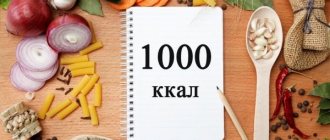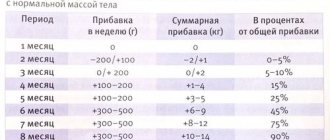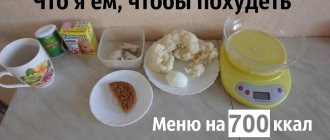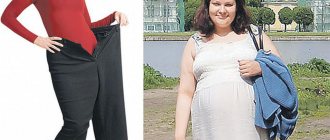The 2000 calorie per day diet does not belong to the category of diets with severe food restrictions and is designed for a long period.
This calorie content allows you to avoid a constant feeling of hunger and provides the body with the necessary amount of energy and microelements, which creates comfortable conditions for gradual weight loss.
But it should be remembered that for people leading a sedentary lifestyle, the daily allowance of 2000 calories may be excessive. Therefore, a certain level of physical activity with this diet is a necessary condition for achieving and maintaining the desired result.
ADDITIONAL INFORMATION ON THIS TOPIC
Manufacturers of sports nutrition The list of the best manufacturers of sports nutrition today is not so long. It is very difficult to gain consumer trust, because, as you know, reputation takes years to develop. Effective diets for weight loss The essence of any diet for weight loss is low calorie content. Remember, the weight will start to go away only when you start burning more calories than you consume. But in order to correctly create an individual diet that will help reduce the number of calories consumed, it is necessary to take into account a number of factors. Diet for women after 40 In this article, we decided to pay attention to the age factor, which should be taken into account both when creating a set of physical exercises and in creating a diet. Glucometers - which is better Today, in any pharmacy you can find a large assortment of glucometers, but choosing the most accurate and reliable one is very difficult. Healthy Foods Some foods have natural properties that can help prevent the development of various diseases, which is a good addition to traditional methods of treatment.
Calculation of calories per day
Every hour we spend 1 calorie to “maintain” one kilogram of body weight. Let's say your weight is 60 kg. If we multiply this figure by 24 (based on the number of hours in a day), we get 1440. However, this calculation is not correct without taking into account the level of mental and physical activity, stress, etc.
For men
For the stronger sex, the issue of daily ration norms is certainly important. And it's not just a matter of trying to stay in good physical shape. Being healthy is always fashionable. And given the fact that stress is associated with stress, modern people have become more attentive to the quality and quantity of food they eat.
Monitoring your caloric intake is the basis of proper nutrition. The difference between women's diets and men's diets is that men have an accelerated metabolic process (metabolism). Therefore, it is easier for them to lose weight than for women. This means that the diet for representatives of the stronger half of humanity should not be too meager.
So, if a man wants to maintain physical fitness at an optimal level for him, but at the same time leads a predominantly inactive lifestyle, then he should be guided by the following norm:
- if a man is from 18 to 30 years old, then he can consume 2400 kcal per day;
- at the age of 31 to 50 years, the daily norm should be 2200 kcal;
- over 50 years old, 2000 kcal will be enough.
If a man’s day proceeds at a rhythm of medium intensity, then he needs:
- at the age of 18 to 30 years, you should consume 2600-2800 kcal;
- at the age of 31 to 50 – 2400-2600 kcal;
- from 50 – 2200–2400 kcal per day.
Actively living men are recommended to consume:
- from 18 to 30 years old you need to consume 3000 kcal;
- at the age of 31 to 50 – 2800–3000 kcal;
- at the age of over 50 – 2400–2800 kcal per day.
For women
As a rule, the female body needs fewer calories than the male body. This is due to the fact that women gain weight faster - this is provided by nature in order to protect the female body for the purpose of full procreation. There is no point in conflicting with nature, but it is very important for any girl and woman to be in shape.
The number of calories allowed to be consumed to maintain weight depends on physical activity. If a girl or woman leads a sedentary lifestyle, then she should learn:
- the daily norm for girls from 18 to 25 years old is about 2000;
- aged 26 to 50 years – 1800 kcal;
- after 50 years – 1600 kcal.
Women and girls leading a moderately active lifestyle should consume:
- at the age of 18 to 25 – without fear for your figure, you can consume 2200 kcal per day;
- from 26 to 50 – recommended 2000 kcal;
- after 50 years the norm is 1800 kcal.
Female representatives who lead an active lifestyle require:
- 18-30 year olds – 2400 kcal;
- for 31-60 year olds it is 2200;
- after 60, 2000 per day is required.
If a woman needs to calculate calories for weight loss, then 500 kcal should be subtracted from these normal indicators and her diet should be compiled depending on the resulting amount. There is a very common belief: to effectively lose weight, the calorie intake should be reduced to 1200 per day.
However, this is only true if the woman leads a sedentary lifestyle. Because it is under this condition that weight loss will be healthy. And a sharp reduction in calorie intake, complemented by high physical activity, can provoke serious health problems: disturbances in the functioning of the cardiovascular system (symptoms - dizziness, nausea, weakness), disruptions in the menstrual cycle (up to amenorrhea), slowdown of metabolism and weakening of the immune system.
The daily calorie intake is the number of kilocalories that the body must receive to perform basic functions to support life, without the formation of reserves. How much energy the human body needs depends on:
- Paula.
- Age.
- Body mass.
- Lifestyle and level of physical activity.
- Metabolic rates.
- Mental state.
For a woman, the norm is 1500-2000 kcal per day, for a man 2200-3000 kcal per day. However, these figures were obtained without taking into account the individual characteristics of a person (weight, lifestyle, height).
Therefore, it is better for each person to independently determine how many kilocalories are needed for normal life. The rate can be calculated as follows:
- Using only body weight. The calculation should be made as follows: multiply body weight by 15, and divide the resulting answer by 0.453. This way you can roughly calculate how many calories you need. In order to lose weight, you will need to slightly reduce the number of calories you consume. This formula is the simplest, but not particularly accurate. Since the calculation uses only body weight and does not take into account either age or level of physical activity.
- Taking into account height, weight and level of physical activity. The calculation is made as follows: (9.99*weight) (6.25*height) - (4.92*age). The resulting figure must be multiplied by the coefficient of physical activity: 1.2 - with a sedentary lifestyle with low physical activity; 1.375 – light physical activity (once every 3 days); 1.55 - average physical activity; 1.725 – daily physical activity and 1.9 with a lifestyle with a high level of physical activity. The resulting figure will be normal. And if you do not exceed the daily norm, then problems with excess weight will not arise. If you still need to lose weight, then you need to slightly reduce the daily norm.
The daily norm for an active lifestyle should be approximately 2600-3200 kcal, for a less active lifestyle approximately 2400-2600 kcal, for a passive lifestyle - 2200-2400. It is better to calculate the daily norm several times, since an error in the calculation can lead to a deficiency or excess of energy.
The first day
Breakfast:
- Crumbled buckwheat porridge (200 g)
- Stewed carrots (250 g) with low-fat sour cream (25 g)
- Adyghe cheese (60 g)
- Milk yoghurt (125 g)
- Coffee with milk (200 ml)
Lunch:
- Rye bread (30 g)
- Low-fat cottage cheese (30 g)
- Apple (150 g)
- Persimmon (80 g)
Dinner:
- Fresh cabbage soup (250 ml)
- Cereal bread (50 g)
- Steamed meat cutlets (150 g)
- Stewed potatoes with green peas and zucchini (400 g)
- Tea (200 ml)
Second day
Breakfast:
- Pancakes with low-fat cottage cheese and raisins (200 g) with low-fat sour cream (25 g)
- Carrot, celery and apple salad with lemon juice and vegetable oil (250 g)
- Tea with lemon (200 ml)
Lunch:
Dinner:
- Vegetarian borscht (250 ml)
- Borodino bread (50 g)
- Cod in tomato sauce with carrots and olives (150 g)
- Boiled rice (200 g)
- Vegetable salad (white cabbage, dill, sweet pepper, green onions) with vegetable oil (250 g)
- Dried fruit compote (200 ml)
Afternoon snack:
Dinner:
- White cabbage with mushrooms and potatoes (400 g)
- Boiled tongue (70 g)
- Riga bread (30 g)
- Rose hip decoction (200 ml)
Some menu examples
Below are sample menus for different types of athletes. They are united by multiple meals and variety.
You will have to calculate the caloric content and the amount of proteins, fats, carbohydrates
Diet for 1500 calories per day
This option is suitable for men who are losing weight and girls who are gaining or maintaining weight.
Breakfast: vegetable omelette with tofu and berry juice / cottage cheese casserole with juice / oatmeal and compote.
Second breakfast (snack): fruit / apple mousse / grapes.
Lunch: light salad and cream of broccoli soup / beet salad, cream of asparagus soup / salad with apple and celery and cream of mushroom soup.
Afternoon snack: chickpea stew and barley with mushrooms and tomatoes / spaghetti, vegetable roll with zucchini / buckwheat and stewed vegetables.
Dinner: eggplant rolls with feta and Caesar salad / lobio with vegetable salad / vegetable cutlets and salad with pineapple.
As you can see, nutrition for athletes can be both varied and healthy.
Day three
Breakfast:
- Oatmeal porridge with skim milk and dried fruits (200g)
- Boiled beets with vegetable oil (150 g)
- Cheese (40 g)
- Black coffee (200 ml)
Lunch:
- Natural yogurt (125 g)
- Cream cracker (15 g)
- Plums (100 g)
Dinner:
- Vegetarian rassolnik (250 ml)
- Bran bread (30 g)
- Turkey (100 g), baked with prunes and potatoes (100 g)
- Salad (tomatoes, cucumbers, herbs, sweet peppers) with lemon juice (250 g)
- Fresh berry compote (200 ml)
Afternoon snack:
- Crispy bread (10 g)
- Low-fat cottage cheese (30 g)
- Watermelon (200 g)
- Melon (200 g)
Dinner:
- Grilled squid (200 g)
- Mixed vegetables with steamed rice (200 g)
- Wholemeal bread (40 g)
- Tomato juice (200 ml)
AMOUNT OF FOOD PER DAY FOR 2000 CALORIES
- A glass of buckwheat (200 gr.) = 125 g carbohydrates + 26 g protein + 640 kcal
- Chicken fillet (500 g) = 100 g protein + 550 kcal
- EGG (with yolk) 5 pieces = 45 g protein + 39 g fat + 540 kcal
- Egg whites 5 pcs = 20 g protein + 100 kcal
- LOW-FAT COOK (200 g) = 36 g protein + 190 kcal
- VEGETABLES 300-500 g (cucumbers, tomatoes, broccoli, etc.) = 15 - 20 g carbohydrates + 70-100 kcal
TOTAL: approximately 2,000 Kcal of which 150 g carbohydrates + 225 g protein + 40 g fat
Explanations for cooking and food selection
- All products are BAKED, COOKED, OR STEWED.
- Cottage cheese needs 0% fat-free or 1-2% low-fat. We don't need extra calories.
- Eggs are needed “0” category (60-70 grams 1 piece). If you are using eggs LESS than grade 0, then consider these changes in your diet.
- We weigh the porridge before cooking, namely as a DRY PRODUCT (one faceted glass = about 200 grams), and not in finished form after cooking.
- If you need to REDUCE calories, then do it primarily through CARBOHYDRATES, i.e. cereals (rice, buckwheat, oatmeal).
- If you are ready to break your diet to lose weight, then do it at the expense of EGG WHITES AND VEGETABLES. This is better than overeating on sweets or starchy foods.
Day four
Breakfast:
- Omelette with spinach and cheese (200 g)
- Sauerkraut with vegetable oil (200 g)
- Cereal bread (50 g)
- Green tea (200 ml)
Lunch:
- Low-fat cottage cheese with herbs and bell pepper (150 g)
- Fruit tea (200 ml)
Dinner:
- Fish soup (250 ml)
- Rye bread (30 g)
- Chicken kebab (100 g)
- Cauliflower with potatoes and tomatoes (400 g)
- Kiwi (100 g)
- Cranberry juice (200 ml)
Afternoon snack:
- Yogurt (200 ml)
- Pear (150 g)
- Apple (150 g)
Dinner:
- Boiled white beans (150 g)
- Stewed vegetables (eggplant, bell pepper, tomatoes, mushrooms, onions) (200 g)
- Wholemeal bread (40 g)
- Fruit jelly (200 g)
- Tea (200 ml)
Day five
Breakfast:
- Muesli with dried fruits and nuts (50 g) with skim milk (200 ml)
- Apples baked with low-fat cottage cheese and raisins (200 g)
- Coffee with milk (200 ml)
Lunch:
- Fruit salad (200 g) with natural yogurt (125 g)
Dinner:
- Cream of porcini mushroom soup (250 ml) with croutons (30 g)
- Steamed river trout (150 g)
- Boiled potatoes with Provencal herbs (200 g)
- Broccoli baked in the oven with low-fat sour cream (300 g)
- Grapefruit (200 g)
Afternoon snack:
- Low-fat kefir (250 ml)
- Drying (15 g)
- Raspberries (200 g)
Dinner:
- Pasta with ketchup (150 g)
- Boiled green beans (200 g)
- Low-fat cottage cheese (100 g) with fresh strawberries (100 g)
- Tea with lemon (200 ml)











